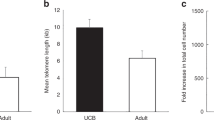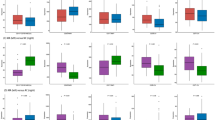Abstract
CFC numbers have shown to correlate with success of engraftment and speed of neutrophil recovery following cord blood (CB) transplantation. To investigate whether the number of Meg-CFC in a CB stem cell preparation might correlate with time to platelet engraftment, we evaluated the frequency of Meg-CFC among all CFC types in 134 CB, 21 adult bone marrow (BM) and 52 cytokine-mobilized peripheral blood (PB) stem cell preparations. The correlation of Meg-CFC with the total number of CFC and mixed cell-CFC was also assessed. The frequency of Meg-CFC was highest in CB and correlated significantly with total CFC numbers (mean 20.8%, correlation coefficient (r) 0.84, P = 0.0001) compared with Meg-CFC from mobilized PB (mean 13.1%, r = 0.29, P = 0.07) and BM (mean 4%, r = 0.39, P = 0.13). In addition, mixed-cell CFC numbers in CB were highly correlated with the total number of Meg-CFC (r = 0.7, P = 0.0001). No such correlations were found with mobilized PB or BM. We conclude that, based on the high degree of correlation between Meg-CFC and non-Meg-CFC numbers in CB, no additional information concerning time to platelet engraftment would be gained by routinely performing Meg-CFC assays in addition to non-Meg-CFC assays. The fact that CB Meg-CFC and mixed-cell CFC are strongly correlated suggests that CB Meg-CFC are more primitive than their counterparts in BM and PB and may reflect the number of stem cells in CB. Bone Marrow Transplantation (2000) 25, 1029–1034.
This is a preview of subscription content, access via your institution
Access options
Subscribe to this journal
Receive 12 print issues and online access
$259.00 per year
only $21.58 per issue
Buy this article
- Purchase on Springer Link
- Instant access to full article PDF
Prices may be subject to local taxes which are calculated during checkout


Similar content being viewed by others
References
Wagner JE, Kernan N, Steinbuch M et al. Allogeneic sibling umbilical cord blood transplantation in children with malignant and non-malignant disease Lancet 1995 346: 214–219
Kurtzberg J, Laughlin M, Graham ML et al. Placental blood as a source of hematopoietic stem cells for transplantation into unrelated recipients New Engl J Med 1996 335: 157–165
Gluckman E, Rocha V, Boyer-Chammard A et al. Outcome of cord-blood transplantation from related and unrelated donors New Engl J Med 1997 337: 373–381
Rubinstein P, Carrier C, Scaradavou A et al. Outcomes of 562 recipients of placental blood transplants from unrelated donors New Engl J Med 1998 339: 1565–1577
Piacibello W, Sanavio F, Severino A et al. Engraftment in nonobese diabetic severe combined immunodeficient mice of human CD34(+) cord blood cells after ex vivo expansion: evidence for the amplification and self-renewal of repopulating stem cells Blood 1999 93: 3736–3749
Piacibello W, Sanavio F, Garetto L et al. Differential growth factor requirement of primitive cord blood hematopoietic stem cell for self-renewal and amplification vs proliferation and differentiation Leukemia 1998 12: 718–727
Piacibello W, Sanavio F, Garetto L et al. Extensive amplification and self-renewal of human primitive hematopoietic stem cells from cord blood Blood 1997 89: 2644–2653
Traycoff CM, Kosak ST, Grigsby S, Srour EF . Evaluation of ex vivo expansion potential of cord blood and bone marrow hematopoietic progenitor cells using cell tracking and limiting dilution analysis Blood 1995 85: 2059–2068
van de Ven C, Ishizawa L, Law P, Cairo MS . IL-11 in combination with SLF and G-CSF or GM-CSF significantly increases expansion of isolated CD34+ cell population from cord blood vs adult bone marrow Exp Hematol 1995 23: 1289–1295
Liu J, Li K, Yuen PM et al. Ex vivo expansion of enriched CD34+ cells from neonatal blood in the presence of thrombopoietin, a comparison with cord blood and bone marrow Bone Marrow Transplant 1999 24: 247–252
To LB, Roberts MM, Haylock DN et al. Comparison of haematological recovery times and supportive care requirements of autologous recovery phase peripheral blood stem cell transplants and allogeneic bone marrow transplants Bone Marrow Transplant 1992 9: 277–284
Weaver CH, Hazelton B, Birch R et al. An analysis of engraftment kinetics as a function of the CD34 content of peripheral blood progenitor cell collections in 692 patients after the administration of myeloablative chemotherapy Blood 1995 86: 3961–3969
Scheid C, Draube A, Reiser M et al. Using at least 5×106/kg CD34+ cells for autologous stem cell transplantation significantly reduces febrile complications and use of antibiotics after transplantations Bone Marrow Transplant 1999 23: 1177–1181
Glaspy J, McNiece I, LeMaistre F et al. Effects of stem cell factor (rhSCF) and filgastrim (rh-CSF) on mobilization of peripheral blood progenitor cells (PBPC) and on hematological recovery posttransplant: early results from a phase I/II study J Clin Oncol 1994 13: 76a
Briddell R, Glaspy J, Shpall EJ et al. Mobilization of myeloid, erythroid and megakaryocyte progenitors by recombinant human stem cell factor (rhSCF) plus filgastrim (rhG-CSF) in patients with breast cancer J Clin Oncol 1994 13: 109a
Briddell R, Glaspy J, Shpall EJ et al. Treatment of breast cancer patients with stem cell factor (rhSCF) and filgastrim (rhG-CSF) mobilizes increased numbers of megakaryocyte progenitors Exp Hematol 1994 22: 26a
Migliaccio AR, Adamson JW, Rubinstein P, Stevens C . Correlations between progenitor cell dose, likelihood to engraft and time to myeloid engraftment in 79 unrelated placental/cord blood transplants Exp Hematol 1997 25: 356a
Rubinstein P, Dobrila L, Rosenfield RR et al. Processing and cryopreservation of placental/umbilical cord blood for unrelated bone marrow reconstitution Proc Natl Acad Sci USA 1995 92: 10119–10122
Kashiwakura I, Sotiropoulos D, Adamson JW . Ex vivo expansion of megakaryocytic colony-forming cells (Meg-CFC) from human umbilical cord blood Blood 1997 90: 538a
Landsdorp PM, Dragowska W, Mayani H . Ontogeny-related changes in proliferative potential of human hematopoietic cells J Exp Med 1993 178: 787–791
Bender JG, Unverzagt K, Walker DE et al. Phenotypic analysis and characterization of CD34+ cells from normal human bone marrow, cord blood, peripheral blood, and mobilized peripheral blood from patients undergoing autologous stem cell transplantation Clin Immunol Immunopathol 1994 70: 10–18
Van Epps DE, Bender J, Lee W, Schilling M et al. Harvesting, characterization, and culture of CD34+ cells from human bone marrow, peripheral blood, and cord blood Blood Cells 1994 20: 411–423
Steen R, Tjonnfjord GE, Egeland T . Comparison of the phenotype and clonogenicity of normal CD34+ cells from umbilical cord blood, granulocyte colony-stimulating factor-mobilized peripheral blood, and adult human bone marrow J Hematother 1994 3: 253–262
Gordon MY, Lewis JL, Scott MA et al. Probability of progenitor renewal (PPR) and production of clonogenic progeny (CFU-GM) by primitive adherent progenitor cells in adult human bone marrow and umbilical cord blood Br J Hematol 1995 90: 744–749
Deutsch VR, Olson TA, Nagler A et al. The response of cord blood megakaryocyte progenitors to IL-3, IL-6 and aplastic canine serum varies with gestational age Br J Haematol 1995 89: 8–16
De Bruyn C, Delforge A, Bron D et al. Comparison of the coexpression of CD38, CD33 and HLA-DR antigens on CD34+ purified cells from human cord blood and bone marrow Stem Cells 1995 13: 281–288
Hao QL, Shah AJ, Thiemann FT et al. A functional comparison of CD34+CD38− cells in cord blood and bone marrow Blood 1995 86: 3745–3753
Migliaccio G, Baiocchi M, Hamel N et al. Circulating progenitor cells in human ontogenesis: response to growth factors and replating potential J Hematother 1996 5: 161–170
Weekx SF, Van Bockstaele DR, Plum J et al. CD34+CD38− and CD34+CD38+ human hematopoietic progenitors from fetal liver, cord blood, and adult bone marrow respond differently to hematopoietic cytokines depending on the ontogenic source Exp Hematol 1998 26: 1034–1042
Wang JC, Doedens M, Dick JE . Primitive human hematopoietic cells are enriched in cord blood compared with adult bone marrow or mobilized peripheral blood as measured by the quantitative in vivo SCID-repopulating cell assay Blood 1997 89: 3919–3924
Nishihira H, Toyoda Y, Miyazaki H et al. Growth of macroscopic human megakaryocyte colonies from cord blood in culture with recombinant human thrombopoietin (c-mpl-ligand) and the effects of gestational age on frequency of colonies Br J Haematol 1996 9: 23–28
Zauli G, Valvassori L, Capitani S . Presence and characteristics of circulating megakaryocyte progenitor cells in human fetal blood Blood 1993 81: 385–390
Banu N, Wang JF, Groopman JE, Avraham H . Modulation of megakaryocytopoiesis by thrombopoietin: the c-Mpl ligand Blood 1995 86: 1331–1338
Nichol JL, Hokom MM, Hornkohl A et al. Megakaryocyte growth and development factor: analysis of in vitro effects on human megakaryopoiesis and endogenous serum levels during chemotherapy-induced thrombocytopenia J Clin Invest 1995 95: 2973–2978
Angchaisuksiri P, Carlson PL, Desypris EN . Effects of recombinant human thrombopoietin on megakaryocyte colony formation and megakaryocyte ploidy by human CD34+ cells in a serum-free system Br J Haematol 1996 93: 13–17
Bruno E, Murray LJ, DiGiusto R et al. Detection of a primitive megakaryocyte progenitor cell in human fetal bone marrow Exp Hematol 1996 24: 552–558
Hagiwara T, Kodama I, Horie K et al. Proliferative properties of human umbilical cord blood megakaryocyte progenitor cells to human thrombopoietin Exp Hematol 1998 26: 228–235
Catani L, Gugliotta L, Campanini E et al. Megakaryocyte progenitors derived from bone marrow or G-CSF-mobilized peripheral blood CD34 cells show a distinct phenotype and responsiveness to interleukin-3 (IL-3) and PEG-recombinant human megakaryocyte growth and development factor (PEG-rHuMGDF) Br J Haematol 1998 100: 207–218
Wyrsch A, dalle Carbonare V, Jansen W et al. Umbilical cord blood from preterm human fetuses is rich in committed and primitive hematopoietic progenitors with high proliferative and self-renewal capacity Exp Hematol 1999 27: 1338–1345
Ratajczak J, Machalinski B, Samuel A et al. The role of thrombopoietin and other cytokines on bone marrow and cord blood CFU-Meg growth under serum-free conditions Folia Histochem Cytobiol 1998 36: 61–66
Zauli G, Vitale M, Visani G et al. In vitro growth of human fetal CD34+ cells in the presence of various combinations of recombinant cytokines under serum-free culture conditions Br J Haematol 1994 86: 461–467
Urashima M, Hoshi Y, Akiyama M et al. Effects of cytokines on hematopoietic progenitor cells in cord blood, in bone marrow, and in peripheral blood mobilized by chemotherapy and G-CSF Acta Paediatr Jpn 1995 37: 21–26
Gehling UM, Ryder JW, Hogan CJ et al. Ex vivo expansion of megakaryocyte progenitors: effect of various growth factor combinations on CD34+ progenitor cells from bone marrow and G-CSF-mobilized peripheral blood Exp Hematol 1997 25: 1125–1139
Migliaccio G, Migliaccio AR, Druzin ML et al. Effects of recombinant human stem cell factor (SCF) on the growth of human progenitor cells in vitro J Cell Physiol 1991 148: 503–509
Migliaccio G, Migliaccio AR, Druzin ML et al. Long-term generation of colony-forming cells in liquid culture of CD34+ cord blood cells in the presence of recombinant human stem cell factor Blood 1992 79: 2620–2627
Acknowledgements
We thank Lorraine Boccone for excellent technical assistance. These studies were supported by the Placental/Cord Blood Program of The New York Blood Center as well as institutional funds from the Blood Center's Lindsley F Kimball Research Institute.
Author information
Authors and Affiliations
Rights and permissions
About this article
Cite this article
von Drygalski, A., Xu, G., Constantinescu, D. et al. The frequency and proliferative potential of megakaryocytic colony-forming cells (Meg-CFC) in cord blood, cytokine-mobilized peripheral blood and bone marrow, and their correlation with total CFC numbers: implications for the quantitation of Meg-CFC to predict platelet engraftment following cord blood transplantation. Bone Marrow Transplant 25, 1029–1034 (2000). https://doi.org/10.1038/sj.bmt.1702401
Received:
Accepted:
Published:
Issue Date:
DOI: https://doi.org/10.1038/sj.bmt.1702401
Keywords
This article is cited by
-
High sensitivity of megakaryocytic progenitor cells contained in placental/umbilical cord blood to the stresses during cryopreservation
Bone Marrow Transplantation (2004)



